Japan Focus
Military Prostitution and the U.S. Military in Asia
Katharine H.S. Moon
Where there are soldiers, there are women who exist for them. This is practically a cliché. History is filled with examples of women as war booty and “camp followers,” their bodies being used for service labor of various kinds, including sex. Contrary to common assumptions in the West, prostitution is not “part of Asian culture.” Just about every culture under the sun has some version of it during times of war and times of peace.
In some ways, military prostitution (prostitution catering to, and sometimes organized by, the military) has been so commonplace that people rarely stop to think about how and why it is created, sustained, and incorporated into military life and warfare. Academic interest and analysis of this issue gained momentum only in the last twenty years and still remains scant and sporadic. Even as interest in women and gender as categories of analysis has increased in many academic disciplines, there is still a question of intellectual “legitimacy,” that is, whether prostitutes, prostitution, and sex work warrant “serious” scholarly attention and resources, especially for students of international politics. After all, it is a highly “personal” and therefore “subjective” matter and prone toward the proverbial “he said/she said” contestation. To boot, many have turned the feminist emphasis on women and agency on its head by glibly claiming that most military prostitutes sought out the work and life of their own free will and therefore are exercising their agency. In this view, it is primarily about women’s personal decisions and responsibility to face the consequences; governments and other institutions of society need not be held accountable.
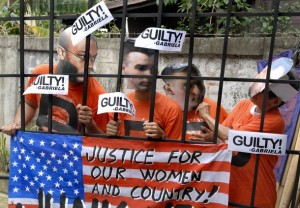
Filipino activists from the Gabriela women’s organization wearing cut-outs of the four accused US Marines of rape, pose standing behind bars in Manila, 23 November 2006.
For decades, key leaders of Asian women’s movements such as Takazato Suzuyo of Okinawa and Matsui Yayori, the well-known Japanese journalist and feminist activist, Aida Santos and women’s organizations like GABRIELA of the Philippines have argued to the contrary. They documented and insisted that U.S. military prostitution in Okinawa/Japan, South Korea, and the Philippines involve a complex “system” of central and local government policies, political repression, economic inequalities and oppression of the underclass, police corruption, debt bondage of women by bar owners, in addition to pervasive sexist norms and attitudes in both the U.S. military and the respective Asian society. In the 1970s and 1980s, when Asian feminists raised these connections, they tended to fault patriarchal and sexist values together with power inequalities emanating from them and the economic and political disparities among nations.
Such individuals and organizations also emphasized the compromised sovereignty of their own governments in relationship with the more powerful U.S. government and military, resulting in the compromised rights and dignity of the Korean, Okinawan, Filipina and other women who “serviced” American military (male) personnel. Aida Santos, a long-time activist opposing U.S. military bases in the Philippines (and later the Visiting Forces Agreement) wrote in the early 1990s that in the Philippines, “[r]acism and sexism are now seen as a fulcrum in the issue of national sovereignty.”[1] Such activists made the case that the personal is indeed political and international. [2] “Olongapo Rose,” a 1988 documentary film by the British Broadcasting Corporation about U.S. military prostitution in the Philippines graphically depicts the various political, economic, cultural, and racial “systems” at work.
Even under authoritarian rule in the 1970s, Filipinas did not hesitate to speak up and campaign nationally and internationally against the Philippines authorities and the U.S. military for abetting and condoning the physical, sexual, and economic exploitation and violence against women who worked in the R&R industry along Olongapo and Subic Bay, where U.S. forces had been stationed until the early 1990s. But in Korea, even progressive activists of the 1970s and 1980s, who fought against military dictatorship, labor repression, and the violation of human rights overlooked military prostitution as a political issue. For one, they had their plates full, challenging the Park Chung Hee and Chun Doo Hwan regimes. Second, as much as some activists criticized the dominant role of the United States in the alliance relationship, others were loath to attack a fundamental institution that safeguarded Korean security. Of course, the legal system was stacked against them. With the National Security Law squarely in place, critics of the U.S. military or the alliance could be thrown into prison, tortured, or killed. Third, military prostitutes were so beneath the political radar screen of most progressives because the women themselves were viewed as “dirty,” lowest of the low, and “tainted” because they slept with foreign soldiers. A highly puritanical and moralistic sense of ethnonationalism among most Koreans had exiled Korean military prostitutes from the larger Korean society and political arena. It is common knowledge among military prostitutes and their advocates that the formers’ family often disowned them upon learning of their “shameful” lives.
But in 1988, Yu Boknim, a Korean democracy activist, and Faye Moon, an American missionary and social activist became mavericks even among progressive dissidents by paying attention to the plight of the Korean gijichon (camptown) women. Together with the assistance of a handful of student activists and the financial support of some Protestant churches, they established Durebang (My Sister’s Place) in 1988 as a counseling center, shelter, and later bakery (to generate income for older women who had left the sex business and younger women who wanted to get out). But despite their efforts to raise awareness of the relationship between the presence of U.S. bases and the growth of this underclass of women and their Amerasian children, most of Korean society continued to ignore the women and their needs. Rather, Yu and Moon found increasing solidarity with their activist counterparts from the Philippines, Okinawa/Japan, and the United States as women began to organize around issues of sexual violence and slavery, militarism, and human rights in the Asia-Pacific.
Currently, military prostitution in Korea has been transformed in line with global economic and migration trends. Foreign nationals, primarily from the Philippines and the former Soviet Union, have become the majority of sex-providers and “entertainers” for the U.S. troops. Young Korean women, with better education and economic and social opportunities than their mothers or grandmothers, are not available for such work. And they are not as easily duped by traffickers. In a more complex, globalized and multicultural sex industry environment, however, political and legal accountability for various problems and conflicts that both the prostitutes and the servicemen encounter become even more difficult to understand and more difficult for activists to target effectively. Nevertheless, on a day-to-day basis, hardworking advocacy organizations on behalf of the women, such as Saewoomtuh, continue to offer shelter, counseling, and health and legal assistance to the best of their ability.
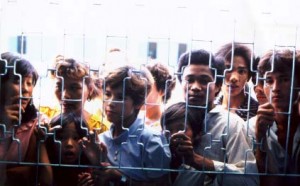
Kids at Amerasian transit center, Ho Chi Minh City, 1992
So, if military prostitution around U.S. bases in Asia has been an institution found wherever US forces are stationed since the mid-20th century-including, in addition to Japan, Okinawa, South Korea and the Philippines, Thailand, Taiwan, the Pacific Islands and many others–and individual activists and concerned organizations have labored to raise political and societal awareness of this issue, why has it reached the pages of the New York Times-through the Korean case-only in 2009? The answer lies in a gradual evolution of international and domestic developments that has created some opening for the issue of military prostitution in Korea to become more public.
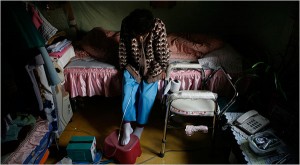
Bae, a former prostitute who worked near US military bases in South Korea. Photo Jean Chung
For starters, the concept of “women’s human rights” and the practice of generating norms and codifying laws have become popularized and prioritized only since the 1990s. Feminist activism on such matters has been around longer, but the “mainstreaming” of women’s human rights is relatively new, with emphasis on the urgency of addressing violence against women, human trafficking, and gender-based economic inequalities.
In East Asia, various regional networks and cooperation among women’s organizations have facilitated the exchange of information about military and civilian forms of prostitution and a wider audience than was available in each national community. The “comfort women” movement, which demanded official apologies, historical accountability, and compensation from the Japanese government for the sexual violence committed against Korean and other women by Japanese troops during the Pacific War, helped shed light on political abuses long regarded as “private” mishaps. Moreover, the social movement around former Japanese “comfort women” had overshadowed advocacy efforts on behalf of the U.S. military prostitutes. The survivors of Japanese sex slavery were older than the survivors of military prostitution, making the claims of the former more urgent. But more than that, activists in the Korean comfort women movement and many of the survivors themselves generally shunned even a remote association with U.S. military prostitutes because the latter were deemed to have freely and willingly sold their bodies. [3] The comfort women movement gained international legitimacy and stature partly because the former victims were viewed as innocents who had been forcibly violated. Nevertheless, the surviving comfort women have faced continuing skepticism about their innocence and purity from the Japanese right.
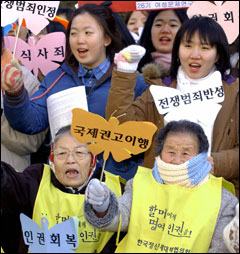
South Korean former comfort women and students shout slogans during a rally demanding full compensation and apology in front of the Japanese embassy in Seoul, January 2005.
But with the comfort women issue having achieved some gains since the Korean movement for redress took off in the early 1990s-Japanese apology, albeit wishy-washy under former Prime Minister Abe Shinzo,[4] private compensation from Japan, support by the United Nations apparatus and numerous NGOs, and most recently, the passage of the nonbinding U.S. House Resolution 121 that called upon the Japanese government to apologize for its sexual enslavement of women during World War II-there is a bit more political space that former military prostitutes might share. It should be noted that the women who desire to seek apology and compensation from the Korean government and the U.S. military are themselves elderly, ill, frail, and without much time left to their lives. They now feel their own urgency to get their life stories out and to claim recognition and redress for their sacrifices.
Additionally, individual incidents of violence against women in U.S. military camptowns, which have been common through the decades of the U.S. presence in Asia, have gained broader attention in these societies since the 1990s. In Korea, the egregious murder of Yun Geumi by a U.S. serviceman in October, 1992 [5] was not unique in terms of the degree of abuse and brutality. But it catalyzed local camptown consciousness about the disproportionate burdens that the villages and towns housing U.S. bases in Korea have borne for decades. And it became a call to action for a small group of Korean progressives to organize on behalf of Korean civilians living and working near the bases. The National Campaign for Eradication of Crimes by U.S. Troops in Korea, which eventually became the leading organization that scrutinizes and documents-and when necessary, mobilizes around-the actions of U.S. commands and the conduct of U.S. troops as they affect Korean civilians, was born in the aftermath of Yun’s murder.[6] But for the most part, Yun’s death remained a localized and politically contained issue in the early-mid-1990s.
In Japan, the highly publicized gang rape of a twelve-year-old Okinawan girl in 1995 by three U.S. Marines galvanized political activism and brought wider attention to military-related violence against women. Unlike the rape of the girl, Yun’s murder did not itself spark a national debate about the presence and prerogatives of the U.S. forces or a crisis in the alliance relationship. On one evel, the murder of a prostitute did not elicit as much public sympathy and ire as the rape of a school girl, which triggered action toward an Okinawan referendum on the bases and the establishment of the joint Japan-U.S. Special Action Committee on Okinawa “to reduce the burden on the people of Okinawa and thereby strengthen the Japan-US alliance.”[7] For Koreans, the timing was not conducive to focusing on violence against camptown women because both Seoul and Washington were hip-deep in the first nuclear crisis concerning North Korea. Hammering out the Agreed Framework of 1994 was the major preoccupation of the United States regarding the Korean peninsula. In 1993-94, the Korean government itself had little interest and leverage to seek justice for a dead prostitute; it was fixated on not being left out of the negotiation process between Pyongyang and Washington. On another level, Korean civil society organizations were still in the process of forming and learning how to shape and adapt to the new political parameters that were being created in the aftermath of formal democratization in 1988. Making local politics and violence against women matter to the larger public and government after four decades to the contrary was new and challenging.
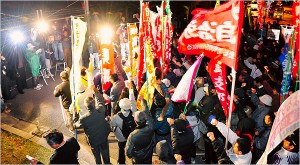
Thousands rally in Chatan town to protest against crimes committed by U.S. troops and to demand a reduced U.S. military presence on Okinawa in March, 2008, after arrest of a U.S. Marine on suspicion of raping a schoolgirl. The arrest sparked outrage and stirred memories of the 1995 rape of a 12-year-old girl that prompted huge anti-base protests.
Okinawans, on the other hand, benefited from opportune timing. For one, a delegation of women representing peace and women’s human rights groups had just returned from the 1995 UN Conference on Women in Beijing. They responded immediately upon learning of the rape by establishing organizations and mobilizing existing networks that were to become key players in regional and international activism addressing U.S. bases, violence against women, anti-militarism, and human rights for the next decade. The fact that Okinawa enjoyed a governor, Ota Masahide, who was bent on asserting new powers of local
autonomy and challenging the central government’s hegemony over Okinawa’s land usage, economic and security arrangements was also instrumental. By contrast, Korea in 1992-93 had just begun to explore the process of decentralizing government, and at the time of the murder of Yun, autonomous local governments did not exist, and local residents’ identity as a legitimate and effective political community was inchoate. Today, however, local administrative autonomy and residents’ sense of empowerment and entitlement are quite robust. Social movements and opposition parties can and do make claims on the
central government and criticize U.S. bases and U.S.-South Korean relations without fearing the repression that had prevailed for most of the history of the Korean republic.[8]
Internal factors within the United States also provide a context in which the older generation of Korean women who worked and lived as sex providers to the U.S. forces can claim official apology and compensation. Since the early-mid 1990s, international trafficking of human beings for sexual labor and other forms of abuse has been an official part of the U.S. policy agenda. The Clinton administration was particularly active in this regard, with the Department of State under Madeleine Albright playing a leading role. Furthermore, in 2000, the U.S. Congress passed the Victims of Trafficking and Violence Protection Act, which established new protections for women in the domestic sex industry who were willing to cooperate with law enforcement authorities to convict traffickers. The law also put the world on notice that the U.S. seeks to be a leader in preventing and combating human trafficking and mandated the State Department to issue annual status reports of various countries’ efforts to fight trafficking.
Moreover, some members of the U.S. media have focused attention on the issue, Nicholas Kristof of the New York Times being the most prominent in recent years. But earlier in 2002, a FOX TV team had travelled to Korea to document the U.S. military’s involvement in the Korean sex industry and in international trafficking of women. This created a big stir in Washington, prompting members of Congress to write to the then Secretary of Defense Donald Rumsfeld to investigate the situation in Korea and other overseas bases. The R&R/sex industry that long had been an integral part of the landscape and the person-to-person interactions between Americans and Koreans became exposed to the larger world and highly newsworthy.
The Pentagon indeed took congressional and media scrutiny seriously and mandated inspector generals to investigate and report on any connection between trafficking and the U.S. military. And in response, commands in Korea cracked down on servicemen and bars suspected of using trafficked women as “hostesses” and entertainers by putting them off limits for periods of time. The U.S. commands also waged public awareness campaigns through radio and periodic education sessions to warn its troops that it does not condone soldiers’ association with prostitution and trafficking. The newspaper for the 2nd Infantry Division, Indianhead, quoted Capt. Kent Bennett, 2nd Inf. Div. Preventive Medicine Officer that “‘[p] rostitution and trafficking are demeaning acts toward women,'” and that by participating, “a Soldier is contributing to the enslavement of women and girls from all over the world.”[9] The article also stated that the U.S. Department of Defense is pushing to change the Uniform Code of Military Justice so that “Soldiers who are found convicted of soliciting prostitution may be dishonorably discharged.” These developments in the U.S. government and military reflect a new sensitivity and responsiveness to public scrutiny and pressures around military prostitution, but it is unclear to what extent institutional changes are systematically planned and enforced and whether the individual conduct of servicemen changes in the long run. These developments also point to a new vulnerability on the part of the U.S. military establishment. They can no longer avoid public oversight over a practice that soldiers and sailors took for granted as part of their “R&R” entitlement for a very long time. But U.S. military policy and behavioral changes that take place now and in the future would come too late for the women who had “serviced” American men in the past.
The domestic and international developments I describe above do matter in terms of whether issues like prostitution, trafficking, violence against women can find a political venue and audience. However, only the individuals who have experienced trafficking, prostitution, and violence can educate us about these conditions as lived realities. And it takes courage to come forward. The elderly women featured in the New York Times have decided that their time has come.
See “Ex-Prostitutes Say South Korea and U.S. Enabled Sex Trade Near Bases” by Choe Sang-Hun
Katharine H.S. Moon is Professor of Political Science at Wellesley College and the author of Sex Among Allies: Military Prostitution in U.S.-Korea Relations, Columbia University Press, 1997.
She wrote this article for The Asia-Pacific Journal: Japan Focus. Posted on January 17, 2009.
Recommended Citation: Katharine H.S. Moon, “Military Prostitution and the U.S. Military in Asia,” The Asia-Pacific Journal, Vol. 3-6-09, January 17, 2009.
See Choe Sang-hun, “Ex-Prostitutes Say South Korea and U.S. Enabled Sex Trade Near Bases,” The New York Times, January 7, 2009.
Notes:
[1] Aida Santos, “Gathering the Dust: The Bases Issue in the Philippines,” in Let the Good Times Roll, eds. Saundra Sturdevant and Brenda Stolzfus (New York: New Press, 1992) p. 40.
[2] Cynthia Enloe, Bananas, Beaches, and Bases: Making Feminist Sense of International Politics (Berkeley, CA: University of California Press, 2001).
[3] See Katharine H.S. Moon, “South Korean Movements against Militarized Sexual Labor,” in Asian Survey (34:2), 1999.
[4] Norimitsu Onishi, “Abe only partly successful in defusing ‘comfort women’ issue,” International Herald Tribune, April 29, 2007. Access date: May 2, 2007.
[5]Yun Geumi’s body was found “naked, bloody, and covered with bruises and contusions-with laundry detergent sprinkled over the crime site. In addition, a coke bottle was embedded in Yun’s uterus and the trunk of an umbrella driven 27cm into her rectum.” From Rainbow Center, Flushing, NY, News Letter # 3, January, 1994, p. 8.
[6] For more detailed discussion, see Katharine H.S. Moon, “Resurrecting Prostitutes and Overturning Treaties: Gender Politics in the South Korean ‘Anti-American’ Movement,” Journal of Asian Studies 66:1 (2007).
[7] Japanese Ministry of Foreign Affairs, “SACO Final Report,” December 2, 1996.
[8] For a comparative analysis of decentralization and its relationship to the U.S. military in Japan, Korea, and the Philippines, Katharine H.S. Moon, “Challenging U.S. Hegemony: Asian Nationalism and Anti-Americanism in East Asia,” in The United States and East Asia: Old Issues and New Thinking, G. John Ikenberry and Chung-in Moon, eds., (Lanham, MD: Rowman & Littlefield, 2007).
[9] Indianhead, October 4, 2004. (Access date: 11 January, 2009).











